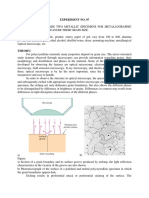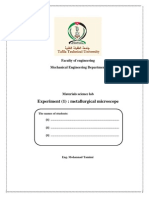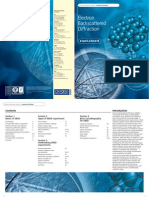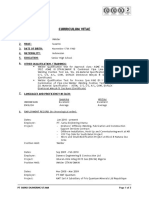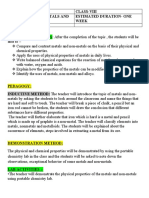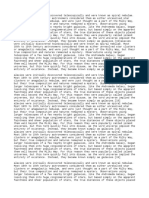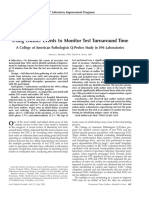1462548896microscopical Examination
1462548896microscopical Examination
Uploaded by
Bahadır TekinCopyright:
Available Formats
1462548896microscopical Examination
1462548896microscopical Examination
Uploaded by
Bahadır TekinOriginal Title
Copyright
Available Formats
Share this document
Did you find this document useful?
Is this content inappropriate?
Copyright:
Available Formats
1462548896microscopical Examination
1462548896microscopical Examination
Uploaded by
Bahadır TekinCopyright:
Available Formats
1.
MICROSCOPICAL EXAMINATION
The microstructural study of a material can provide information regarding the morphology and
distribution of constituent phases as well as the nature and pattern of certain crystal
imperfections. Optical metallography is a basic tool of material scientists, since the equipment
is relatively inexpensive and the images can be obtained and interpreted easily. Distribution and
morphology of the phases can be studied and, if their properties are known, a quantitative
analysis of the micrographs provides some information about the bulk properties of the
specimen. A limited study of line and surface informations is also possible with the optical
microscope.
In order to obtain reproducible results, with good contrast in the image, the specimen surface is
polished and subsequently etched with appropriate reagents before microscopic examination.
In a polished specimen, the etching not only delineates grain boundaries, but also allows the
different phases to be distinguished by differences in brightness, shape, and color of the grain.
Differences in contrast may result from differences in light absorption characteristics of the
phases. Etching results in preferential attack or preferential colouring of the surface. The
preferential attack is electrochemical corrosion; it is well known that different materials corrode
at different rates. Grain boundaries are often anodic to the bulk metal in the interior of the grain
and so are etched away preferentially and delineated. Staining is produced by the deposition of
solid etch product on the specimen surface. This is formed by chemical reaction between the
etchant and the specimen. Under favorable conditions the use of a proper etchant enables the
identification of constituents. Failure analysis depends a great deal on metallographic
examination.
Microstructural examination can provide quantitative information about the following
parameters:
1) The grain size of specimens
2) The amount of interfacial area per unit volume
3) The dimensions of constituent phases
4) The amount and distribution of phases.
1.1. Metallurgical (Optic) Microscope
The microstructure of the metals and alloys is investigated by metallurgical microscopes. An
optic microscope has the maximum 2000x magnification and 1000Å separation efficiency
(lateral dissolution). For higher magnification analyses, electron microscopy has to be used,
which is not in the scope of this study. Unlike biological microscopes, metallurgical
microscopes must use reflected light. Figure 3 presents a simplified ray diagram of the
illuminating and imaging system of a metallurgical microscope.
Light incident upon the specimen is reflected back from the specimen surface. Any light that
reflects back from specimen features which are approximately normal to the optical axis (i.e.
features that are perpendicular to the incident light beam) will enter the objective, pass through
the plane glass reflector, travel on to the eyepiece, and will form the bright portion of the image
one sees. Any light that is reflected back from features inclined to the optical axis (i.e. features
that are not perpendicular to the incident light beam) will be scattered and will not enter the
objective. Such features will thereby appear dark in the image one sees. The final image of the
specimen, formed by the eyepiece(s) of the microscope, is thus bright for all features normal to
the optical axis and dark for inclined features. In this way, the various microstructural features
of a metallographic specimen (such as grain boundaries that have been etched to produce
grooves with inclined edges, precipitate particles, and non-metallic inclusions) are all revealed
in the image of the specimen. Figure 4 presents a schematic diagram showing bright and dark
image areas corresponding to reflection from normal or inclined features on the specimen
surface.
Figure 1. Specimen image under bright-field illumination.
Figure 2. Schematic representation of an etched sample having two phases.
HOMEWORK
1. Draw schematically the view of the sample detected under the optical microscope with 100x
magnification, before and after the etching processes.
2. Please indicate precisely the problems that you faced while preparing the your sample for the
microscopic examination. Moreover, explain in detail the solution that you find to resolve all
those problems.
You might also like
- NTU Materials Engineering EB5 - Microstructure of MaterialsDocument12 pagesNTU Materials Engineering EB5 - Microstructure of MaterialsArya Adijaya100% (1)
- GRADE 7 WorksheetsDocument28 pagesGRADE 7 WorksheetsJaymar Sarvida100% (3)
- Lab 3 - Microstructure Analysis PDFDocument4 pagesLab 3 - Microstructure Analysis PDFMifzal Izzani100% (1)
- Ningaloo Coast World Heritage Area Marine Park Zones MapsDocument1 pageNingaloo Coast World Heritage Area Marine Park Zones Mapsapi-431958928No ratings yet
- Metallography: Preparing Metallographic SpecimensDocument10 pagesMetallography: Preparing Metallographic SpecimensIhsan1991 YusoffNo ratings yet
- 4 Notes-1Document28 pages4 Notes-1SAJITH NF100% (1)
- Metallography Is The Study of Metals by Optical and Electron Microscopes - Structures WhichDocument4 pagesMetallography Is The Study of Metals by Optical and Electron Microscopes - Structures WhichVale KaranfilovicNo ratings yet
- Macro Micro - En.idDocument6 pagesMacro Micro - En.idYuliantari YuliantariNo ratings yet
- MEL-416 Lab Report On OM &SEMDocument7 pagesMEL-416 Lab Report On OM &SEMAjay VermaNo ratings yet
- Introduction To Polarized Light MicrosDocument28 pagesIntroduction To Polarized Light Microssamridhi_gaur_1No ratings yet
- MT101 L1 04 Microstucture ExaminationDocument2 pagesMT101 L1 04 Microstucture ExaminationPasan LiyanaarachchiNo ratings yet
- MSE315 Fall-2022 2Document31 pagesMSE315 Fall-2022 2gencozo31No ratings yet
- MicrostructureDocument8 pagesMicrostructureRamathi GunasekeraNo ratings yet
- Microscopy Gorkem 118Document4 pagesMicroscopy Gorkem 118sarkimasNo ratings yet
- A Guide To Etching Specialty Alloys For Microstructural EvaluationDocument11 pagesA Guide To Etching Specialty Alloys For Microstructural EvaluationNecdet KaragülleNo ratings yet
- EN23534018 - 5C - Microstructural Examination of SteelDocument11 pagesEN23534018 - 5C - Microstructural Examination of Steeldragonpplayz123No ratings yet
- Lecture4 3Document16 pagesLecture4 3arulmuruguNo ratings yet
- Metallurgical MicroscopeDocument3 pagesMetallurgical MicroscopeShakil Ahmed100% (1)
- Optical Microscopy:: Sectioning Is To Select A Sample That Is Representative of The Material To BeDocument5 pagesOptical Microscopy:: Sectioning Is To Select A Sample That Is Representative of The Material To BeMuhammad Ali HaiderNo ratings yet
- Instrumentalanalysis Chapter5 FabDocument122 pagesInstrumentalanalysis Chapter5 FabKavintharan BaskaranNo ratings yet
- Assignmen 10Document25 pagesAssignmen 10muhammadahmadjura60No ratings yet
- What Are Different Types of Microscopic Techniques That Are Available For Investigating The Microstructure of MaterialsDocument6 pagesWhat Are Different Types of Microscopic Techniques That Are Available For Investigating The Microstructure of Materialsmuhammadahmadjura60No ratings yet
- Lab ManualDocument21 pagesLab ManualMetal deptNo ratings yet
- Material S. Presentation 1Document77 pagesMaterial S. Presentation 1Dagmawi HailuNo ratings yet
- Ams - Metallography of SpecimenDocument8 pagesAms - Metallography of SpecimenkarthigeyanNo ratings yet
- Characterization of Nanoparticles: DR - Rabia RazzaqDocument40 pagesCharacterization of Nanoparticles: DR - Rabia RazzaqHafsa MansoorNo ratings yet
- Microscopic Characterization of Dental Materials and Its Application in Orthodontics - A ReviewDocument7 pagesMicroscopic Characterization of Dental Materials and Its Application in Orthodontics - A ReviewInternational Journal of Innovative Science and Research TechnologyNo ratings yet
- Grain Size PDFDocument4 pagesGrain Size PDFSarthak SachdevaNo ratings yet
- Jaganath Assignment 2Document4 pagesJaganath Assignment 2gagandeep singhNo ratings yet
- PE429 - Lectures 3 & 4Document19 pagesPE429 - Lectures 3 & 4عبدالله المصريNo ratings yet
- MT Lab Manual Final - 2019Document102 pagesMT Lab Manual Final - 2019Brundhan B.ANo ratings yet
- Chapter 4 PDFDocument10 pagesChapter 4 PDFMohd FaizNo ratings yet
- Metallurgy LabDocument26 pagesMetallurgy LabSudarshan GNo ratings yet
- Nanometrology 114007Document7 pagesNanometrology 114007abhishek.g.770306No ratings yet
- Materials Assign1 - M. Ehtisham (333201)Document16 pagesMaterials Assign1 - M. Ehtisham (333201)TolphasNo ratings yet
- CH 4Document42 pagesCH 4hailayNo ratings yet
- The Electron MicroscopeDocument8 pagesThe Electron MicroscopeHelp MeNo ratings yet
- 2020 MSM Lab ManualDocument31 pages2020 MSM Lab Manualdhruv dabhiNo ratings yet
- Structure CharacterizationDocument2 pagesStructure CharacterizationBenNo ratings yet
- Microscopic TechniquesDocument41 pagesMicroscopic Techniques36 MakerzZNo ratings yet
- ASE Metallurgy ManualDocument21 pagesASE Metallurgy ManualKamel FedaouiNo ratings yet
- Metallography - An Introduction - Learn & Share - Leica MicrosystemsDocument9 pagesMetallography - An Introduction - Learn & Share - Leica MicrosystemsharieduidNo ratings yet
- File 1 - Enginerring Physics Text BookDocument104 pagesFile 1 - Enginerring Physics Text BookHet PatidarNo ratings yet
- MSM Experiment No 4Document4 pagesMSM Experiment No 4zakariyasheikh22No ratings yet
- Topic3B SEM TotalDocument95 pagesTopic3B SEM Totalmoi2apuiaNo ratings yet
- Group #1 Metallurgical Microscope - 095147Document3 pagesGroup #1 Metallurgical Microscope - 095147umarlucky1819No ratings yet
- Catam Lab Manual NewDocument68 pagesCatam Lab Manual NewHarika Pothamshetty-15No ratings yet
- Scanning Electron MicrosDocument5 pagesScanning Electron MicrosNegar HosseinianNo ratings yet
- Title Microstructure Examination of SteelDocument8 pagesTitle Microstructure Examination of SteelRashmika Uluwatta100% (1)
- Experiment (1) : Metallurgical Microscope: Faculty of Engineering Mechanical Engineering DepartmentDocument5 pagesExperiment (1) : Metallurgical Microscope: Faculty of Engineering Mechanical Engineering DepartmentSean RoachNo ratings yet
- Electron Backscattered Diffraction: Further ReadingDocument16 pagesElectron Backscattered Diffraction: Further Readingyourself_bigfoot_comNo ratings yet
- Chapter 3 Microsopy and Preparation of SpecimenDocument63 pagesChapter 3 Microsopy and Preparation of SpecimenMARIAM AFIFAH NUBAHARINo ratings yet
- Title PageDocument11 pagesTitle PageRaja Muaz AliNo ratings yet
- Group 6 - Exp 7Document27 pagesGroup 6 - Exp 7Arrianna PeterNo ratings yet
- Metallography: Dr. Mohd Arif Anuar Mohd SallehDocument22 pagesMetallography: Dr. Mohd Arif Anuar Mohd SallehNurulAtirahNoroziNo ratings yet
- Characterization Techniques 6.1 Scanning Electron Microscope (Sem)Document7 pagesCharacterization Techniques 6.1 Scanning Electron Microscope (Sem)RanNo ratings yet
- Scanning Electron MicrosDocument5 pagesScanning Electron MicrosNegar HosseinianNo ratings yet
- Cell Structure 2015-16Document33 pagesCell Structure 2015-16ADEEL AHMADNo ratings yet
- Electron Microscopy (Mohsen Mhadhbi)Document145 pagesElectron Microscopy (Mohsen Mhadhbi)erin.csf0702No ratings yet
- Scanning Electron MicroscopeDocument6 pagesScanning Electron MicroscopeRaza AliNo ratings yet
- Macro ExaminationDocument8 pagesMacro ExaminationPaktam NabilNo ratings yet
- Photovoltaic Modeling HandbookFrom EverandPhotovoltaic Modeling HandbookMonika Freunek MüllerNo ratings yet
- Influence of Striking Edge Radius 2 Vs 8 MM On InsDocument27 pagesInfluence of Striking Edge Radius 2 Vs 8 MM On InsBahadır TekinNo ratings yet
- Charpy Impact Test Results On Five Materials and NDocument32 pagesCharpy Impact Test Results On Five Materials and NBahadır TekinNo ratings yet
- V005t12a001 87 GT 1Document6 pagesV005t12a001 87 GT 1Bahadır TekinNo ratings yet
- Wood - LPG-LNG Accidents by MaureenDocument22 pagesWood - LPG-LNG Accidents by MaureenBahadır TekinNo ratings yet
- A Guide To Sulfidation and High Temperature H2 H2S Corrosion ManagementDocument39 pagesA Guide To Sulfidation and High Temperature H2 H2S Corrosion ManagementBahadır TekinNo ratings yet
- Krautkrämer Ultrasonic Transducers: For Flaw Detection and SizingDocument48 pagesKrautkrämer Ultrasonic Transducers: For Flaw Detection and SizingBahadır Tekin100% (1)
- KEIYU NDT Ultrasonic TransducerDocument6 pagesKEIYU NDT Ultrasonic TransducerBahadır TekinNo ratings yet
- Product Manual 5335 2-Wire Transmitter With HART ProtocolDocument26 pagesProduct Manual 5335 2-Wire Transmitter With HART ProtocolgobikulandaisamyNo ratings yet
- ELECTROMAGNETISM (Short Inside Book)Document17 pagesELECTROMAGNETISM (Short Inside Book)daniyal.king55No ratings yet
- Welder CV - SusantoDocument3 pagesWelder CV - SusantoDavid BarimbingNo ratings yet
- ASQ Master Set PDFDocument100 pagesASQ Master Set PDFКонстантин КрахмалевNo ratings yet
- The Quarterly Review of Economics and Finance: Ibrahim D. RaheemDocument6 pagesThe Quarterly Review of Economics and Finance: Ibrahim D. RaheemSyed Saeed AhmedNo ratings yet
- Exploring ManualDocument4 pagesExploring Manual9fbpjddbxzNo ratings yet
- Msds 100102 Silicone Platinum CatalystDocument6 pagesMsds 100102 Silicone Platinum CatalystLukman Nul HakimNo ratings yet
- Activity #4: Name: Section/Group: Subject: Analytical Chemistry Lab Bachelor in Medical Laboratory ScienceDocument3 pagesActivity #4: Name: Section/Group: Subject: Analytical Chemistry Lab Bachelor in Medical Laboratory ScienceDan Christian BlanceNo ratings yet
- Advertisement EstDocument1 pageAdvertisement Estjamil ahmedNo ratings yet
- Probability On Simple EventsDocument64 pagesProbability On Simple EventsKaren Bangibang WalayNo ratings yet
- Case Study Heat Transfer Enhancement by Nano FluidsDocument18 pagesCase Study Heat Transfer Enhancement by Nano FluidsNARAYANAN SNo ratings yet
- Science 3Document31 pagesScience 3johairaalimudinNo ratings yet
- Chapter - 5: (Introduction To Euclid's Geometry)Document3 pagesChapter - 5: (Introduction To Euclid's Geometry)LatoyaWatkinsNo ratings yet
- Final Lesson Plan Class VIIIDocument26 pagesFinal Lesson Plan Class VIIIarchanaNo ratings yet
- DPM 4207 - Turk - Assgn - 1 - Joseph Et GradedDocument4 pagesDPM 4207 - Turk - Assgn - 1 - Joseph Et Gradedkizzy McraeNo ratings yet
- 2.1 Increasing and Decreasing PDFDocument9 pages2.1 Increasing and Decreasing PDFpatrick alvesNo ratings yet
- Bmo 2024 (Ali Maths)Document8 pagesBmo 2024 (Ali Maths)Rachide DaniNo ratings yet
- Chemical and Structural Diversity of Hybrid Layered Double Perovskite HalidesDocument11 pagesChemical and Structural Diversity of Hybrid Layered Double Perovskite HalidesNacho Delgado FerreiroNo ratings yet
- GalaksijaDocument4 pagesGalaksijaISHAK BULJUBASICNo ratings yet
- Mesozoic Era InformationDocument10 pagesMesozoic Era InformationPadillaNo ratings yet
- Iso 8402-1994Document23 pagesIso 8402-1994Davood OkhovatNo ratings yet
- Madeline Kraus Special Education Student Teaching SummaryDocument1 pageMadeline Kraus Special Education Student Teaching Summaryapi-526732343No ratings yet
- Q2 - LE - Mathematics 4 - Lesson 4 - Week 4Document12 pagesQ2 - LE - Mathematics 4 - Lesson 4 - Week 4cherrylou.adigueNo ratings yet
- Using Outlier Events To Monitor Test Turnaround TimeDocument8 pagesUsing Outlier Events To Monitor Test Turnaround TimeWilmer UcedaNo ratings yet
- ELS - Final-Module - 20-08082020Document26 pagesELS - Final-Module - 20-08082020Marife83% (6)
- Midterm ModuleDocument13 pagesMidterm ModuleElizer ContilloNo ratings yet
- Validation DharamshalaDocument10 pagesValidation Dharamshala172-MEET-18No ratings yet
- M1B521614 Ophthalmic Anatomy and PhysiologyDocument1 pageM1B521614 Ophthalmic Anatomy and PhysiologySofina MukhtarNo ratings yet



























